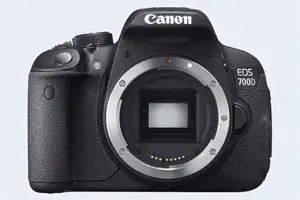Canon 700D vs Ricoh GR II
The Canon EOS 700D (called Canon T5i in some regions) and the Ricoh GR II are two digital cameras that were officially introduced, respectively, in March 2013 and June 2015. The 700D is a DSLR, while the GR II is a fixed lens compact. Both cameras are equipped with an APS-C sensor. The Canon has a resolution of 17.9 megapixels, whereas the Ricoh provides 16.1 MP.
Below is an overview of the main specs of the two cameras as a starting point for the comparison.

Check 700D offers at
ebay.com

Check GR II offers at
ebay.com
Going beyond this snapshot of core features and characteristics, what are the differences between the Canon EOS 700D and the Ricoh GR II? Which one should you buy? Read on to find out how these two cameras compare with respect to their body size, their imaging sensors, their shooting features, their input-output connections, and their reception by expert reviewers.
Body comparison
The physical size and weight of the Canon 700D and the Ricoh GR II are illustrated in the side-by-side display below. The two cameras are presented according to their relative size. Three consecutive perspectives from the front, the top, and the back are available. All size dimensions are rounded to the nearest millimeter.
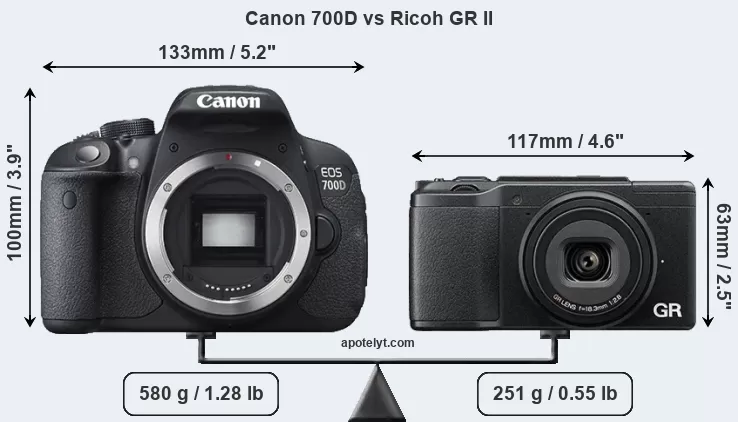
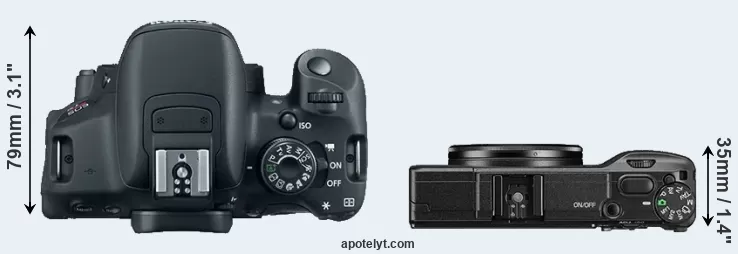
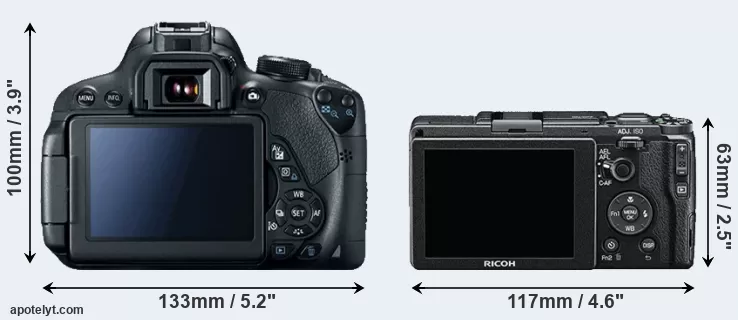
If the front view area (width x height) of the cameras is taken as an aggregate measure of their size, the Ricoh GR II is considerably smaller (45 percent) than the Canon 700D. In this context, it is worth noting that neither the 700D nor the GR II are weather-sealed.
The above size and weight comparisons are to some extent incomplete and possibly misleading, as the GR II has a lens built in, whereas the 700D is an interchangeable lens camera that requires a separate lens. Attaching the latter will add extra weight and bulk to the setup. You can compare the optics available for the 700D and their specifications in the Canon EF Lens Catalog.
Concerning battery life, the 700D gets 440 shots out of its Canon LP-E8 battery, while the GR II can take 320 images on a single charge of its Ricoh DB-65 power pack. The power pack in the GR II can be charged via the USB port, which can be very convenient when travelling.
The following table provides a synthesis of the main physical specifications of the two cameras and other similar ones. If you want to switch the focus of the display and review another camera pair, you can move across to the CAM-parator tool and choose from the broad selection of possible camera comparisons there.

| # | Camera Model |
Camera Width |
Camera Height |
Camera Depth |
Camera Weight |
Battery Life |
Weather Sealing |
Camera Launch |
Launch Price (USD) |
Street Price |
|
|---|---|---|---|---|---|---|---|---|---|---|---|
| 1. | Canon 700D | 133 mm | 100 mm | 79 mm | 580 g | 440 | n | Mar 2013 | 649 | ebay.com | |
| 2. | Ricoh GR II | 117 mm | 63 mm | 35 mm | 251 g | 320 | n | Jun 2015 | 699 | ebay.com | |
| 3. | Canon 750D | 132 mm | 101 mm | 78 mm | 555 g | 440 | n | Feb 2015 | 749 | ebay.com | |
| 4. | Canon 760D | 132 mm | 101 mm | 78 mm | 565 g | 440 | n | Feb 2015 | 649 | ebay.com | |
| 5. | Canon 1200D | 130 mm | 100 mm | 78 mm | 480 g | 500 | n | Feb 2014 | 449 | ebay.com | |
| 6. | Canon G7 X | 103 mm | 60 mm | 40 mm | 304 g | 210 | n | Sep 2014 | 699 | ebay.com | |
| 7. | Canon 100D | 117 mm | 91 mm | 69 mm | 407 g | 380 | n | Mar 2013 | 549 | ebay.com | |
| 8. | Canon 650D | 133 mm | 100 mm | 79 mm | 575 g | 440 | n | Jun 2012 | 849 | ebay.com | |
| 9. | Canon M | 109 mm | 66 mm | 32 mm | 298 g | 230 | n | Jul 2012 | 599 | ebay.com | |
| 10. | Canon 600D | 133 mm | 100 mm | 80 mm | 570 g | 440 | n | Feb 2011 | 599 | ebay.com | |
| 11. | Canon 550D | 129 mm | 98 mm | 62 mm | 530 g | 440 | n | Feb 2010 | 699 | ebay.com | |
| 12. | Canon 500D | 129 mm | 98 mm | 62 mm | 520 g | 400 | n | Mar 2009 | 799 | ebay.com | |
| 13. | Fujifilm X70 | 113 mm | 64 mm | 44 mm | 340 g | 330 | n | Jan 2016 | 799 | ebay.com | |
| 14. | Panasonic GM5 | 99 mm | 60 mm | 36 mm | 211 g | 220 | n | Sep 2014 | 749 | ebay.com | |
| 15. | Ricoh GR | 117 mm | 61 mm | 35 mm | 245 g | 290 | n | Apr 2013 | 799 | ebay.com | |
| 16. | Sony RX100 III | 102 mm | 58 mm | 41 mm | 290 g | 320 | n | May 2014 | 799 | ebay.com | |
| Note: Measurements and pricing do not include easily detachable parts, such as add-on or interchangeable lenses or optional viewfinders. | |||||||||||
Any camera decision will obviously take relative prices into account. The listed launch prices provide an indication of the market segment that the manufacturer of the cameras have been targeting. Normally, street prices remain initially close to the MSRP, but after a couple of months, the first discounts appear. Later in the product cycle and, in particular, when the replacement model is about to appear, further discounting and stock clearance sales often push the camera price considerably down. Then, after the new model is out, very good deals can frequently be found on the pre-owned market.
Sensor comparison
The size of the imaging sensor is a crucial determinant of image quality. All other things equal, a large sensor will have larger individual pixel-units that offer better low-light sensitivity, wider dynamic range, and richer color-depth than smaller pixels in a sensor of the same technological generation. Further, a large sensor camera will give the photographer additional creative options when using shallow depth-of-field to isolate a subject from its background. On the downside, larger sensors are more costly to manufacture and tend to lead to bigger and heavier cameras and lenses.
Both cameras under consideration feature an APS-C sensor, but their sensors differ slightly in size. The sensor area in the GR II is 11 percent bigger. As a result of these sensor size differences, the cameras have format factors, respectively, of 1.6 (700D) and 1.5. Both cameras have a native aspect ratio (sensor width to sensor height) of 3:2.
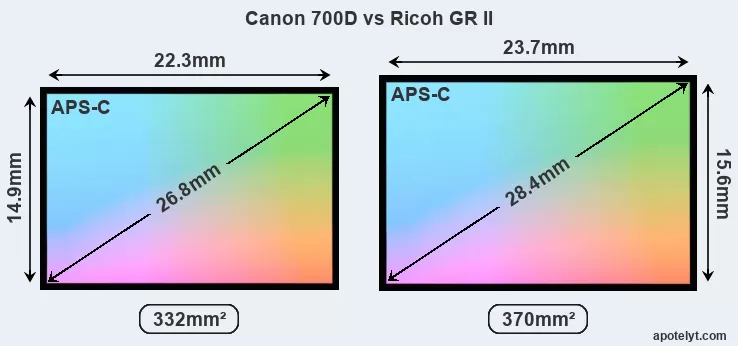
Despite having a smaller sensor, the Canon 700D offers a higher resolution of 17.9 megapixels, compared with 16.1 MP of the Ricoh GR II. This megapixels advantage comes at the cost of a higher pixel density and a smaller size of the individual pixel (with a pixel pitch of 4.31μm versus 4.79μm for the GR II). Moreover, it should be noted that the GR II is much more recent (by 2 years and 2 months) than the 700D, and its sensor will have benefitted from technological advances during this time that further enhance the light gathering capacity of its pixel-units. Coming back to sensor resolution, it should be mentioned that the GR II has no anti-alias filter installed, so that it can capture all the detail its sensor resolves.
The resolution advantage of the Canon 700D implies greater flexibility for cropping images or the possibility to print larger pictures. The maximum print size of the 700D for good quality output (200 dots per inch) amounts to 25.9 x 17.3 inches or 65.8 x 43.9 cm, for very good quality (250 dpi) 20.7 x 13.8 inches or 52.7 x 35.1 cm, and for excellent quality (300 dpi) 17.3 x 11.5 inches or 43.9 x 29.3 cm. The corresponding values for the Ricoh GR II are 24.6 x 16.3 inches or 62.6 x 41.5 cm for good quality, 19.7 x 13.1 inches or 50.1 x 33.2 cm for very good quality, and 16.4 x 10.9 inches or 41.7 x 27.6 cm for excellent quality prints.
The 700D has on-sensor phase detect pixels, which results in fast and reliable autofocus acquisition even during live view operation.
The Canon EOS 700D has a native sensitivity range from ISO 100 to ISO 12800, which can be extended to ISO 100-25600. The corresponding ISO settings for the Ricoh GR II are ISO 100 to ISO 25600 (no boost).
Technology-wise, both cameras are equipped with CMOS (Complementary Metal–Oxide–Semiconductor) sensors. Both cameras use a Bayer filter for capturing RGB colors on a square grid of photosensors. This arrangement is found in most digital cameras.
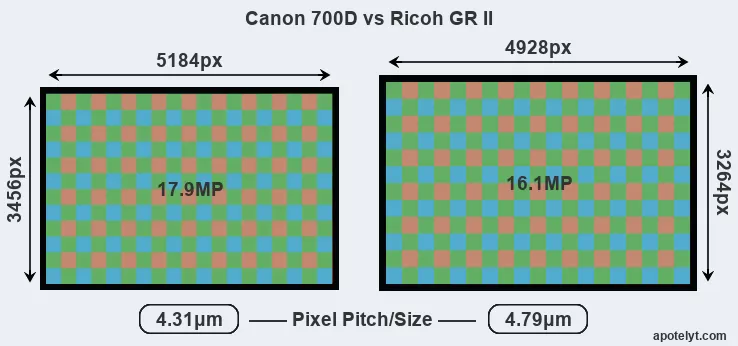
Since 2007, DXO Mark has published sensor performance measurements that have been derived using a consistent methodology. This service is based on lab testing and assigns an overall score to each camera sensor, as well as ratings for dynamic range ("DXO Landscape"), color depth ("DXO Portrait"), and low-light sensitivity ("DXO Sports"). Of the two cameras under consideration, the GR II offers substantially better image quality than the 700D (overall score 19 points higher). The advantage is based on 1.9 bits higher color depth, 2.5 EV in additional dynamic range, and 0.7 stops in additional low light sensitivity. The following table provides an overview of the physical sensor characteristics, as well as the sensor quality measurements for a selection of comparators.

| # | Camera Model |
Sensor Class |
Resolution (MP) |
Horiz. Pixels |
Vert. Pixels |
Video Format |
DXO Portrait |
DXO Landscape |
DXO Sports |
DXO Overall |
|
|---|---|---|---|---|---|---|---|---|---|---|---|
| 1. | Canon 700D | APS-C | 17.9 | 5184 | 3456 | 1080/30p | 21.7 | 11.2 | 681 | 61 | |
| 2. | Ricoh GR II | APS-C | 16.1 | 4928 | 3264 | 1080/30p | 23.6 | 13.7 | 1078 | 80 | |
| 3. | Canon 750D | APS-C | 24.0 | 6000 | 4000 | 1080/30p | 22.7 | 12.0 | 919 | 71 | |
| 4. | Canon 760D | APS-C | 24.0 | 6000 | 4000 | 1080/30p | 22.6 | 12.0 | 915 | 70 | |
| 5. | Canon 1200D | APS-C | 17.9 | 5184 | 3456 | 1080/30p | 21.9 | 11.3 | 724 | 63 | |
| 6. | Canon G7 X | 1-inch | 20.0 | 5472 | 3648 | 1080/60p | 23.0 | 12.7 | 556 | 71 | |
| 7. | Canon 100D | APS-C | 17.9 | 5184 | 3456 | 1080/30p | 21.8 | 11.3 | 843 | 63 | |
| 8. | Canon 650D | APS-C | 17.9 | 5184 | 3456 | 1080/30p | 21.7 | 11.2 | 722 | 62 | |
| 9. | Canon M | APS-C | 17.9 | 5184 | 3456 | 1080/30p | 22.1 | 11.2 | 827 | 65 | |
| 10. | Canon 600D | APS-C | 17.9 | 5184 | 3456 | 1080/30p | 22.1 | 11.5 | 793 | 65 | |
| 11. | Canon 550D | APS-C | 17.9 | 5184 | 3456 | 1080/30p | 22.1 | 11.5 | 784 | 66 | |
| 12. | Canon 500D | APS-C | 15.1 | 4752 | 3168 | 1080/20p | 21.7 | 11.5 | 663 | 63 | |
| 13. | Fujifilm X70 | APS-C | 16.0 | 4896 | 3264 | 1080/60p | 23.7 | 13.0 | 1608 | 80 | |
| 14. | Panasonic GM5 | Four Thirds | 15.8 | 4592 | 3448 | 1080/60p | 22.1 | 11.7 | 721 | 66 | |
| 15. | Ricoh GR | APS-C | 16.1 | 4928 | 3264 | 1080/30p | 23.6 | 13.5 | 972 | 78 | |
| 16. | Sony RX100 III | 1-inch | 20.0 | 5472 | 3648 | 1080/60p | 22.4 | 12.3 | 495 | 67 | |
| Note: DXO values in italics represent estimates based on sensor size and age. | |||||||||||
Many modern cameras are not only capable of taking still images, but can also record movies. Both cameras under consideration have a sensor with sufficiently fast read-out times for moving pictures, and both provide the same movie specifications (1080/30p).
Feature comparison
Apart from body and sensor, cameras can and do differ across a variety of features. For example, the 700D has an optical viewfinder, which can be very useful when shooting in bright sunlight. In contrast, the GR II relies on live view and the rear LCD for framing. That said, the GR II can be equipped with an optional viewfinder – the GV-1. The adjacent table lists some of the other core features of the Canon 700D and Ricoh GR II along with similar information for a selection of comparators.

| # | Camera Model |
Viewfinder (Type or 000 dots) |
Control Panel (yes/no) |
LCD Specifications (inch/000 dots) |
LCD Attach- ment |
Touch Screen (yes/no) |
Max Shutter Speed * |
Max Shutter Flaps * |
Built-in Flash (yes/no) |
Built-in Image Stab |
|
|---|---|---|---|---|---|---|---|---|---|---|---|
| 1. | Canon 700D | optical | n | 3.0 / 1040 | swivel | Y | 1/4000s | 5.0/s | Y | n | |
| 2. | Ricoh GR II | optional | n | 3.0 / 1230 | fixed | n | 1/4000s | 4.0/s | Y | n | |
| 3. | Canon 750D | optical | n | 3.0 / 1040 | swivel | Y | 1/4000s | 5.0/s | Y | n | |
| 4. | Canon 760D | optical | Y | 3.0 / 1040 | swivel | Y | 1/4000s | 5.0/s | Y | n | |
| 5. | Canon 1200D | optical | n | 3.0 / 460 | fixed | n | 1/4000s | 3.0/s | Y | n | |
| 6. | Canon G7 X | none | n | 3.0 / 1040 | tilting | Y | 1/2000s | 6.5/s | Y | Y | |
| 7. | Canon 100D | optical | n | 3.0 / 1040 | fixed | Y | 1/4000s | 4.9/s | Y | n | |
| 8. | Canon 650D | optical | n | 3.0 / 1040 | swivel | Y | 1/4000s | 5.0/s | Y | n | |
| 9. | Canon M | none | n | 3.0 / 1040 | fixed | Y | 1/4000s | 4.3/s | n | n | |
| 10. | Canon 600D | optical | n | 3.0 / 1040 | swivel | n | 1/4000s | 3.7/s | Y | n | |
| 11. | Canon 550D | optical | n | 3.0 / 1040 | fixed | n | 1/4000s | 3.7/s | Y | n | |
| 12. | Canon 500D | optical | n | 3.0 / 920 | fixed | n | 1/4000s | 3.4/s | Y | n | |
| 13. | Fujifilm X70 | optional | n | 3.0 / 1040 | tilting | Y | 1/4000s | 8.0/s | Y | n | |
| 14. | Panasonic GM5 | 1166 | n | 3.0 / 921 | fixed | Y | 1/500s | 5.8/s | n | n | |
| 15. | Ricoh GR | optional | n | 3.0 / 1230 | fixed | n | 1/4000s | 4.0/s | Y | n | |
| 16. | Sony RX100 III | 1440 | n | 3.0 / 1229 | tilting | n | 1/2000s | 10.0/s | Y | Y | |
| Note: *) Information refers to the mechanical shutter, unless the camera only has an electronic one. | |||||||||||
One differentiating feature between the two cameras concerns the touch sensitivity of the rear screen. The 700D has a touchscreen, while the GR II has a conventional panel. Touch control can be particularly helpful, for example, for setting the focus point.
The 700D has an articulated LCD that can be turned to be front-facing. This characteristic will be appreciated by vloggers and photographers who are interested in snapping selfies. In contrast, the GR II does not have a selfie-screen.The Ricoh GR II has an intervalometer built-in. This enables the photographer to capture time lapse sequences, such as flower blooming, a sunset or moon rise, without purchasing an external camera trigger and related software.
Concerning the storage of imaging data, both the 700D and the GR II write their files to SDXC cards. Both cameras can use UHS-I cards, which provide for Ultra High Speed data transfer of up to 104 MB/s.
Connectivity comparison
For some imaging applications, the extent to which a camera can communicate with its environment can be an important aspect in the camera decision process. The table below provides an overview of the connectivity of the Canon EOS 700D and Ricoh GR II and, in particular, the interfaces the cameras (and selected comparators) provide for accessory control and data transfer.

| # | Camera Model |
Hotshoe Port |
Internal Mic / Speaker |
Microphone Port |
Headphone Port |
HDMI Port |
USB Port |
WiFi Support |
NFC Support |
Bluetooth Support |
|
|---|---|---|---|---|---|---|---|---|---|---|---|
| 1. | Canon 700D | Y | stereo / mono | Y | - | mini | 2.0 | - | - | - | |
| 2. | Ricoh GR II | Y | stereo / mono | - | - | micro | 2.0 | Y | Y | - | |
| 3. | Canon 750D | Y | stereo / mono | Y | - | mini | 2.0 | Y | Y | - | |
| 4. | Canon 760D | Y | stereo / mono | Y | - | mini | 2.0 | Y | Y | - | |
| 5. | Canon 1200D | Y | mono / mono | - | - | mini | 2.0 | - | - | - | |
| 6. | Canon G7 X | - | stereo / mono | - | - | micro | 2.0 | Y | Y | - | |
| 7. | Canon 100D | Y | mono / mono | Y | - | mini | 2.0 | - | - | - | |
| 8. | Canon 650D | Y | stereo / mono | Y | - | mini | 2.0 | - | - | - | |
| 9. | Canon M | Y | stereo / mono | Y | - | mini | 2.0 | - | - | - | |
| 10. | Canon 600D | Y | mono / mono | Y | - | mini | 2.0 | - | - | - | |
| 11. | Canon 550D | Y | stereo / - | Y | - | mini | 2.0 | - | - | - | |
| 12. | Canon 500D | Y | mono / mono | - | - | mini | 2.0 | - | - | - | |
| 13. | Fujifilm X70 | Y | stereo / mono | Y | - | micro | 2.0 | Y | - | - | |
| 14. | Panasonic GM5 | Y | stereo / mono | - | - | micro | 2.0 | Y | - | - | |
| 15. | Ricoh GR | Y | mono / mono | - | - | micro | 2.0 | - | - | - | |
| 16. | Sony RX100 III | - | stereo / mono | - | - | micro | 2.0 | Y | Y | - |
It is notable that the 700D has a microphone port, which is missing on the GR II. Such an external microphone input can help to substantially improve the quality of audio recordings when a good external microphone is used.
Both the 700D and the GR II have been discontinued, but can regularly be found used on ebay. The 700D was replaced by the Canon 750D, while the GR II was followed by the Ricoh GR III. Further information on the features and operation of the 700D and GR II can be found, respectively, in the Canon 700D Manual (free pdf) or the online Ricoh GR II Manual.
Review summary
So what is the bottom line? Is the Canon 700D better than the Ricoh GR II or vice versa? The listing below highlights the relative strengths of the two models.

Advantages of the Canon EOS 700D:
- More detail: Offers more megapixels (17.9 vs 16.1MP) with a 5% higher linear resolution.
- Better moiré control: Has an anti-alias filter to avoid artificial patterns to appear in images.
- Better live-view autofocus: Features on-sensor phase-detection for more confident autofocus.
- Better sound: Can connect to an external microphone for higher quality sound recording.
- Easier framing: Has an optical viewfinder for image composition and settings control.
- More flexible LCD: Has a swivel screen for odd-angle shots in portrait or landscape orientation.
- Fewer buttons to press: Is equipped with a touch-sensitive rear screen to facilitate handling.
- More selfie-friendly: Has an articulated screen that can be turned to be front-facing.
- Faster burst: Shoots at higher frequency (5 vs 4 flaps/sec) to capture the decisive moment.
- More flexible: Can take a variety of interchangeable lenses, including specialty optics.
- Longer lasting: Can take more shots (440 versus 320) on a single battery charge.
- More heavily discounted: Has been available for much longer (launched in March 2013).

Arguments in favor of the Ricoh GR II:
- Maximized detail: Lacks an anti-alias filter to exploit the sensor's full resolution potential.
- Better image quality: Scores substantially higher (19 points) in the DXO overall evaluation.
- Richer colors: Generates noticeably more natural colors (1.9 bits more color depth).
- More dynamic range: Captures a broader range of light and dark details (2.5 EV of extra DR).
- Better low-light sensitivity: Can shoot in dim conditions (0.7 stops ISO advantage).
- More detailed LCD: Has a higher resolution rear screen (1230k vs 1040k dots).
- Easier time-lapse photography: Has an intervalometer built-in for low frequency shooting.
- Ready to shoot: Comes with an integrated lens, while the 700D requires a separate lens.
- More compact: Is smaller (117x63mm vs 133x100mm) and will fit more readily into a bag.
- Less heavy: Has a lower weight even though it has a lens built in (unlike the 700D).
- Easier travel charging: Can be conveniently charged via its USB port.
- Easier file upload: Has wifi built in for automatic backup or image transfer to the web.
- Easier device pairing: Supports NFC for fast wireless image transfer over short distances.
- More modern: Reflects 2 years and 2 months of technical progress since the 700D launch.
If the count of relative strengths (bullet points above) is taken as a measure, the GR II emerges as the winner of the match-up (14 : 12 points). However, the pertinence of the various camera strengths will differ across photographers, so that you might want to weigh individual camera traits according to their importance for your own imaging needs before making a camera decision. A professional wedding photographer will view the differences between cameras in a way that diverges from the perspective of a travel photog, and a person interested in cityscapes has distinct needs from a macro shooter. Hence, the decision which camera is best and worth buying is often a very personal one.
How about other alternatives? Do the specifications of the Canon 700D and the Ricoh GR II place the cameras among the top in their class? Find out in the latest Best DSLR Camera and Best Prime Lens Compact Camera listings whether the two cameras rank among the cream of the crop.
In any case, while the specs-based evaluation of cameras can be instructive in revealing their potential as photographic tools, it remains partial and cannot reveal, for example, the shooting experience and imaging performance when actually working with the 700D or the GR II. User reviews, such as those found at amazon, can sometimes inform about these issues, but such feedback is often incomplete, inconsistent, and biased.
Expert reviews
This is where reviews by experts come in. The following table reports the overall ratings of the cameras as published by some of the major camera review sites (amateurphotographer [AP], cameralabs [CL], digitalcameraworld [DCW], dpreview [DPR], ephotozine [EPZ], photographyblog [PB]). As can be seen, the professional reviewers agree in many cases on the quality of different cameras, but sometimes their assessments diverge, reinforcing the earlier point that a camera decision is often a very personal choice.

| # | Camera Model |
AP score |
CL score |
DCW score |
DPR score |
EPZ score |
PB score |
Camera Launch |
Launch Price (USD) |
Street Price |
|
|---|---|---|---|---|---|---|---|---|---|---|---|
| 1. | Canon 700D | .. | .. | .. | 76/100 | 4.5/5 | 4.5/5 | Mar 2013 | 649 | ebay.com | |
| 2. | Ricoh GR II | .. | .. | .. | .. | 4.5/5 | 4.5/5 | Jun 2015 | 699 | ebay.com | |
| 3. | Canon 750D | 5/5 | .. | .. | 75/100 | 4.5/5 | 4.5/5 | Feb 2015 | 749 | ebay.com | |
| 4. | Canon 760D | 5/5 | + | .. | 77/100 | 4.5/5 | 4.5/5 | Feb 2015 | 649 | ebay.com | |
| 5. | Canon 1200D | 3/5 | + | .. | .. | 4/5 | 4.5/5 | Feb 2014 | 449 | ebay.com | |
| 6. | Canon G7 X | 4/5 | + + | .. | 77/100 | 4.5/5 | 4.5/5 | Sep 2014 | 699 | ebay.com | |
| 7. | Canon 100D | 4/5 | + | .. | 78/100 | 4/5 | 4/5 | Mar 2013 | 549 | ebay.com | |
| 8. | Canon 650D | 4/5 | + + | .. | 77/100 | 4.5/5 | 4.5/5 | Jun 2012 | 849 | ebay.com | |
| 9. | Canon M | 3/5 | + | .. | .. | 4/5 | 4/5 | Jul 2012 | 599 | ebay.com | |
| 10. | Canon 600D | 3/5 | o | .. | 77/100 | 4.5/5 | 4.5/5 | Feb 2011 | 599 | ebay.com | |
| 11. | Canon 550D | .. | + + | .. | 77/100 | 4/5 | 4.5/5 | Feb 2010 | 699 | ebay.com | |
| 12. | Canon 500D | .. | + + | .. | 74/100 | 4.5/5 | 4.5/5 | Mar 2009 | 799 | ebay.com | |
| 13. | Fujifilm X70 | 4.5/5 | .. | .. | 76/100 | 4.5/5 | 4.5/5 | Jan 2016 | 799 | ebay.com | |
| 14. | Panasonic GM5 | 3.5/5 | + | .. | 77/100 | 5/5 | 4.5/5 | Sep 2014 | 749 | ebay.com | |
| 15. | Ricoh GR | 5/5 | .. | .. | 79/100 | 4.5/5 | 4.5/5 | Apr 2013 | 799 | ebay.com | |
| 16. | Sony RX100 III | 5/5 | + + | .. | 82/100 | 4.5/5 | 5/5 | May 2014 | 799 | ebay.com | |
| Note: (+ +) highly recommended; (+) recommended; (o) reviewed; (..) not available. | |||||||||||
The review scores listed above should be treated with care, though. The assessments were made in relation to similar cameras of the same technological generation. Thus, a score needs to be put into the context of the launch date and the launch price of the camera, and rating-comparisons among cameras that span long time periods or concern very differently equipped models make little sense. Also, please note that some of the review sites have changed their methodology and reporting over time.

Check 700D offers at
ebay.com

Check GR II offers at
ebay.com
Other camera comparisons
Did this review help to inform your camera decision process? If you would like to see a different side-by-side camera review, just use the search menu below. Alternatively, you can follow any of the listed hyperlinks for comparisons that others found interesting.
- Canon 700D vs Fujifilm X-T30
- Canon 700D vs Nikon D3
- Canon 700D vs Nikon D4S
- Canon 700D vs Nikon D600
- Canon 700D vs Nikon Z6 II
- Canon 700D vs Olympus E-M10 IV
- Canon T3i vs Ricoh GR II
- Nikon 1 J4 vs Ricoh GR II
- Nikon D5200 vs Ricoh GR II
- Olympus E-PL2 vs Ricoh GR II
- Panasonic S1R vs Ricoh GR II
- Ricoh GR II vs Sony A99
Specifications: Canon 700D vs Ricoh GR II
Below is a side-by-side comparison of the specs of the two cameras to facilitate a quick review of their differences and common features.
| Camera Model | Canon 700D | Ricoh GR II |
|---|---|---|
| Camera Type | Digital single lens reflex | Fixed lens compact camera |
| Camera Lens | Canon EF mount lenses | 28mm f/2.8 |
| Launch Date | March 2013 | June 2015 |
| Launch Price | USD 649 | USD 699 |
| Sensor Specs | Canon 700D | Ricoh GR II |
| Sensor Technology | CMOS | CMOS |
| Sensor Format | APS-C Sensor | APS-C Sensor |
| Sensor Size | 22.3 x 14.9 mm | 23.7 x 15.6 mm |
| Sensor Area | 332.27 mm2 | 369.72 mm2 |
| Sensor Diagonal | 26.8 mm | 28.4 mm |
| Crop Factor | 1.6x | 1.5x |
| Sensor Resolution | 17.9 Megapixels | 16.1 Megapixels |
| Image Resolution | 5184 x 3456 pixels | 4928 x 3264 pixels |
| Pixel Pitch | 4.31 μm | 4.79 μm |
| Pixel Density | 5.39 MP/cm2 | 4.35 MP/cm2 |
| Moiré control | Anti-Alias filter | no AA filter |
| Movie Capability | 1080/30p Video | 1080/30p Video |
| ISO Setting | 100 - 12,800 ISO | 100 - 25,600 ISO |
| ISO Boost | 100 - 25,600 ISO | no Enhancement |
| Image Processor | DIGIC 5 | GR Engine V |
| DXO Sensor Quality (score) | 61 | 80 |
| DXO Color Depth (bits) | 21.7 | 23.6 |
| DXO Dynamic Range (EV) | 11.2 | 13.7 |
| DXO Low Light (ISO) | 681 | 1078 |
| Screen Specs | Canon 700D | Ricoh GR II |
| Viewfinder Type | Optical viewfinder | Viewfinder optional |
| Viewfinder Field of View | 95% | |
| Viewfinder Magnification | 0.53x | |
| LCD Framing | Live View | Live View |
| Rear LCD Size | 3.0inch | 3.0inch |
| LCD Resolution | 1040k dots | 1230k dots |
| LCD Attachment | Swivel screen | Fixed screen |
| Touch Input | Touchscreen | no Touchscreen |
| Shooting Specs | Canon 700D | Ricoh GR II |
| Focus System | Phase-detect AF | Contrast-detect AF |
| Continuous Shooting | 5 shutter flaps/s | 4 shutter flaps/s |
| Time-Lapse Photography | no Intervalometer | Intervalometer built-in |
| Fill Flash | Built-in Flash | Built-in Flash |
| Storage Medium | SDXC cards | SDXC cards |
| Single or Dual Card Slots | Single card slot | Single card slot |
| UHS card support | UHS-I | UHS-I |
| Connectivity Specs | Canon 700D | Ricoh GR II |
| External Flash | Hotshoe | Hotshoe |
| USB Connector | USB 2.0 | USB 2.0 |
| HDMI Port | mini HDMI | micro HDMI |
| Microphone Port | External MIC port | no MIC socket |
| Wifi Support | no Wifi | Wifi built-in |
| Near-Field Communication | no NFC | NFC built-in |
| Body Specs | Canon 700D | Ricoh GR II |
| Battery Type | Canon LP-E8 | Ricoh DB-65 |
| Battery Life (CIPA) | 440 shots per charge | 320 shots per charge |
| In-Camera Charging | no USB charging | USB charging |
| Body Dimensions |
133 x 100 x 79 mm (5.2 x 3.9 x 3.1 in) |
117 x 63 x 35 mm (4.6 x 2.5 x 1.4 in) |
| Camera Weight | 580 g (20.5 oz) | 251 g (8.9 oz) |

Check 700D offers at
ebay.com

Check GR II offers at
ebay.com
Did you notice an error on this page? If so, please get in touch, so that we can correct the information.
